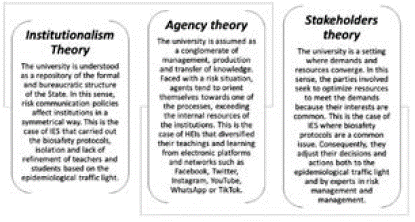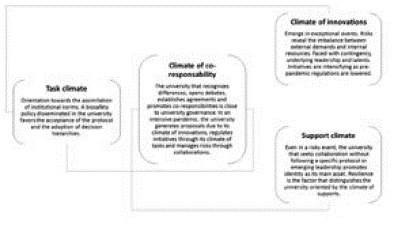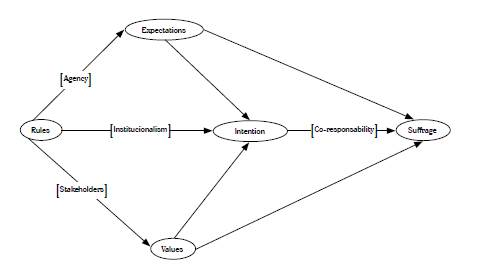Introduction
Until August 2021. the pandemic has taken on the existence of four million individuals, although the media have shown under-records due to asymptomatic cases, as well as in the comparative dissemination of institutional figures (Garza et al. 2021). The establishment of this comparative agenda revealed the differences between the rulers and the ruled in the face of the pandemic (Sandoval et al. 2021). These are axes and topics of discussion that legitimize or question the State's strategy. In the case of networks, there are adherents, sympathizers, or activists of the State who confront those who question the mitigation and containment policies of the pandemic (Espinoza et al. 2019). In this area, the government s strategy consists of the dissemination of vaccine supply and immunization images with priority to older adults.
In tins way. the State's governance strategy lies in the establishment of a risk management agenda directed towards sympathizers, activists, and adherents, even when this propaganda has been questioned by opponents (Garcia. 2020). This conflict between the government and the governed is oriented by the media to build a public agenda. In this strategic phase, public health is the central axis of the anti-Covid-19 policy.
In the educational field, the return to the traditional classroom involves a risk calculated by the parties involved. In front of the virtual classroom that supposes an ostentatious expense, the traditional classroom is a less expensive alternative but riskier in terms of infections, diseases, and deaths for a sector that is distinguished by being asymptomatic before Covid-19 (Juárez et al. 2021). Studies on university governance point to differences within Higher Education Institutions (HEIs). In the case of the return to classes interrupted by the pandemic, the debate revokes around conflicts between federal authorities and the university community. It is true that autonomy allows HEIs to define their return to classes, but their decision to comply with the State's strategy has repercussions on the basic and secondary education system (Hernández et al., 2021). That is. if universities delay their return to the traditional classroom, then the basic and middle subsystem could support the decision, alluding to the experience of HEIs. Consequently, it is necessary to inquire about the effect of the policy of returning to the traditional classroom on a subsector that is distinguished by its mobilization capacity, such as students.
Governance models revolve around the relationship between the State and the academic community. The emphasis on the relationship between the university and the labour market monopolizes the educational agenda (Garcia et al. 2019). The evaluation, accreditation, and certification of the quality of the processes as well as products saturates the discussion. Faced with the pandemic, the studies have only been imitated to diagnose risk perceptions in the face of lack of refinement and return to the traditional classroom. The works delve into the impact of the virtual classroom on teaching and learning. The discussion revolves around the acceptance of technology for the virtual classroom and the replacement of the teacher as the axis of teaching (Garcia, 2019). The investigations that are closest to analysing the differences between the parties are those related to knowledge management. That is. the formation of human capital is close to the study of the strategy of returning to face-to-face classes.
The objective of this work was to contrast a governance strategy model to promote the consensus of return to classes interrupted by the pandemic at a university in central Mexico.
Are there significant differences between the strategic dimensions of governance with respect to the observations of the present study?
The premises that support this work allude to the fact that governance, in its strategic stage, disseminates information related to the pandemic to position adherents, sympathizers, and militants, as 'well as guide their decisions and voting intentions in favour of the regime (Aguilar et al. 2018). In this process of managing the pandemic, the propaganda related to the snuffing of vaccines and immunizations in priority sectors affects the actors, reflecting the differences and coincidences in a system for the prevention of infections, diseases, and deaths (Sánchez et al., 2020). Thus, the dimensions reported in the literature will be different with respect to the factors established in the present study (Garcia. 2018). This is so. because the State's governance strategy assumes the codification and translation of information that only a reduced sector of voters manages to codify (Sánchez et al. 2018). This is the case of the academic community mainly the teaching and student community, it is still the latter that promotes or rejects the propaganda of the State, influencing the elections.
Theory of university governance
The theoretical and conceptual frameworks that explain the relationship between health policies and institutional strategies in the face of Covid-19 suggest that political, academic and student actors can be analyzed from their bureaucratic structure, their initiatives and expectations (see Figure 1).
Traditional institutionalism states that the actors have the necessary information to face a common problem (Garcia et al. 2016). If such risk events are contingent or uncertain, the bureaucratic structure and apparatus should focus on the diffusion of external demands and internal resources to the institutions. In this way. traditional institutionalism assumes that the pandemic is a problem of diffusion of the State towards its institutions and actors. If mitigation and containment policies are sufficiently disseminated in the institution, then the strategies 'will be relevant in reducing the pandemic.
However, the specialization of knowledge is continuous and even the expert actors cannot concentrate enough data to reduce their decision errors. Consequently, the new institutionalism proposes the design of health policy based on risk scenarios (Carreón et al. 2017). A contingent situation, such as the pandemic, means that the actors direct their decisions and actions towards minimizing costs and maximizing benefits.
The traditional and the new institutionalism suppose that the actors adhere to a State project. Both institutionalisms bet on the authority of the government to guide society through policies, strategies, and programs (Quintero et al.. 2017). In a risky context such as the pandemic, informational uncertainly limits institutionalism. Consequently, proposals from innovative actors such as agents emerge.
Institutions acquire a rationality limited by information. The data update shows areas of opportunity that the innovative agents will attend with management, production, and transfer of knowledge (Molina et al. 2019). This is the case of HEIs authorized to reduce the transmission of the pandemic, as well as anticipating risk scenarios.
The opportunities generated by institutionalism and optimized by agents with innovations, suppose a scenario of high competition and reduced cooperation (Aguilar et al. 2016). Even from the perspective of human capital, academic, professional, and labor training is determined by the scarcity of resources and process innovation. In fact, the formation of intellectual capital supposes a collaboration oriented by common objectives, tasks, and goals, but limited to leaderships and talents.
In an escalation of the pandemic, the scarcity or abundance of information favors the balance between external demands and internal resources of a university (Aldana et al. 2019). The agents try to correct the areas of informational opportunity with management, production, and transfer of knowledge. Leaders and talents develop intangible assets through collaboration and competition.
However, the actors distance themselves in their positions and proposals in the face of a health crisis (Martinez et al. 2019). Consequently, around potential cases of contagion, illness, and death, social support is activated. The stakeholder approach complements institutionalism and agency. If the pandemic triggers a supportive and collaborative response, then the parties involved have overcome the information crisis.
The three approaches related to institutionalism. the agency, and the parties involved open the discussion around a comprehensive approach (Delgado et al. 2018). University governance understood as the dialogue of perspectives would explain the effect of the pandemic and biosafety policies in HEIs. The pandemic as risk management would activate a biosafety protocol whose results can be anticipated from the perspective of university governance.
University governance studies
The empirical evidence related to university governance revolves around the relationships between educational, administrative, and student actors (see Figure 2). The studies warn that the differences between the actors, favor decisions and actions oriented by the task climate (Garcia et al. 2018). Faced with the asymmetries of external demands and internal resources, the parties involved transfer their conflicts towards the redistribution of functions. In other words, the pandemic would generate a favorable disposition to tasks, inhibiting proposals and innovations.
The task climate inhibits the innovation climate because the redistribution of functions contravenes the proposals. The consolidation of initiatives supposes a collaborative work. Instead, the task climate suggests a job focused on functions (Garcia et al. 2015). Consequently, neither the climate of innovations nor the climate of support is a priority in a climate of tasks. This is the case of institutions focused on complying with the biosafety protocol without considering prevention or support in the event of a risk.
In a different sense, the universities that reduce the tasks arguing that in the event of risk events an exceptional synergy is necessary, promote the climate of innovations (García et al. 2021). A scenario in which resources are scarce and demands are increasing anticipates the climate of innovations. The opportunities underlying the health and economic crisis force agents to propose solutions. Research confirms the diversification of innovative factors in risk scenarios. The studies also warn of a reduction in innovative dimensions given the incidence of the State in the universities.
The studies on the factors that explain the climate of tasks and the factors that anticipate the climate of innovations, suggest the importance of the climate of supports (Carreón et al. 2018). Universities that focus their interest on the integration of their talents and leaders promote a climate of support. The relationships between teachers, administrators, and students acquire greater importance than their proposals and obedience to biosecurity.
Universities that promote a climate of co-responsibility are distinguished by integrating the climate of tasks, innovations, and support. University governance involves discussion, consensus, and corporate responsibility (Garcia et al. 2019). The universities that are concerned with opening the discussion of their challenges and challenges in the face of the pandemic, establish agreements and co-responsibilities, are close to governance.
Modelling of university governance
A model includes the axes, trajectories, and relationships of variables and central indicators in the research agenda (see Figure 1). Based on the theoretical, conceptual, and empirical frameworks reviewed from 2019 to 2021. it is possible to model university governance. From the institutional point of view the pandemic, when assumed as a normative structure, suggests an association with participation. In this 'way. the first axis of discussion and modeling lies in the prediction of a decision or action from the normative climate. In this axis of debate, the pandemic is considered as an externality of the regulatory system and therefore affects the intentions to carry out an action (Garcia et al. 2017). This is the case of the university, which in the face of the pandemic generates a series of guidelines derived from biosafety protocols. Then, its members establish a decision and action criteria based on the information available, modifying their rules only if the structure is threatened.
Adjacent to the main axis that goes from institutional norms to intentions, emerges the trajectory of the agency (Garcia et al. 2017). Human capital training universities that try to make initiatives, proposals, and innovations stand out in institutional crises. Consequently, leaders and talents become intangible assets that determine intentions and actions. Academic and student participation is influenced by the expectations of agreements and benefits.
A third stakeholder axis suggests values. The social support that the actors manifest is reflected in their knowledge networks (Garcia. 2021). Risk management in the face of the pandemic lies in solidarity collaboration. The production of knowledge to face the pandemic consists of revealing the emotions of members. Information transfer is relative to subjective well-being. Universities that highlight stakeholders preserve the climate of relationships and support.
The axis that distinguishes the model poses a relationship between intentions and suffrage (Carreón et al. 2014). Universities moving towards governance insist that an action will be the result of deliberation, planning, and systematization based on available information: in this sense, the climate of co-responsibility suggests a debate and prior consensus, therefore, the intention to cam" out an action will determine the suffrage or any other participation mechanism.
Method
Given that governance has been approached from the description of its actors, as well as their perceptions, a descriptive and cross-sectional work was conducted with a selection of students who earn" out their social services and professional practices (Garcia et al. 2016). Previous studies suggest that governance is structured in conflict, negotiation, agreements, and co-responsibilities. The relationship between the type of conflict suggests the establishment and scope of a public agenda: this is the case of public services where the increase generates a conflict between authorities and users, the instruments that measure these policies reach minimum levels of consistency, in tins sense, validity is structured in four dimensions of the governance process (Juárez et al. 2021). The dimension of the conflict is indicated by differences between the actors, the negotiation refers to the coincidences between the actors, regarding the agreements, these are appreciated with the expected resources, co-responsibilities are appreciated in the management of resources.
A non-experimental, exploratory, and cross-cut quantitative stud}' was performed: a non-probabilistic selection of 253 students from a public university of the State of Mexico was conducted. The criterion of inclusion-exclusion went from being written in the computer lab. to belonging to a social network, and to seeking information for the preparation of tasks, works, practices, expositions, dynamics, and thesis or research reports: 120 of the students were women (M = 19.5 years of age and SD = 3.15 years), and 133 were men (M = 22.5 years of age and SD = 4.26 years).
Two scales of perceptions and voting intention of Carreón (2016) were used. The Consensus Perceptions Scale included 14 items related to expected benefits and consensus expectations, the Voting Intentions Scale included 7 items related to the election probabilities based on an electoral preference.
The corresponding permission was requested for the application of the instrument in the classroom, once the students were told that the study would not affect positively or negatively their partial or final scores, they proceeded to give them the survey advising that they had a maximum of 20 minutes to answer, subsequently, the respondents signed their informed consent. The data were captured in the Statistical Package for Social Sciences (SPSS) and the Analysis of Moments Structures (AMOS) software in versions 10 and 6.0 respectively.
The multivariate analyses were carried out with previous requirements of normal distribution, reliability, and validity for which the parameters of kurtosis. alpha, and factorial weight were used. Once the psychometric properties were established, we proceeded to estimate the correlations between each of the eight factors with respect to themselves using the "phi" statistic (Villegas et al. 2018).
The dependency ratios were calculated with the parameter "beta" between the factor and the indicators, as well as the use of the "epsilon" statistic for the relations between estimation errors and the manifested variables. Finally, the contrast of the structural model was performed with the parameter's chi square, goodness of fit. and residual (Hernández et al. 2018).
Results
Attack 1 shows alpha values above the minimum required to establish an internal consistency between the scales, which in the case of expectations (alpha of 0893) includes two factors: expected benefits (alpha of 0.891 and 25% of the variance total explained) and consensual expectations (alpha of 0.885 with 17% of the total variance explained). In the case of the intention to vote (alpha of 0.880 and 28% of the total variance explained). The consistency and convergence of the indicators in the established factors suggest that governance is a multi-dimensional phenomenon. This is so because the risk communication strategy in the face of the pandemic produces asymmetric effects on audiences, that is to say. the messages generate a governance spread in three preponderant dimensions. The implications of reliability in university governance are seen in the measurement of consistent decisions and actions. A reduced level of reliability supposes an exacerbated institutionalism vis-à-vis agency and solidarity support. Consequently, university governance would be minimized by the norms and hierarchies dictated by the State.
Table 1 Descriptions of the instrument
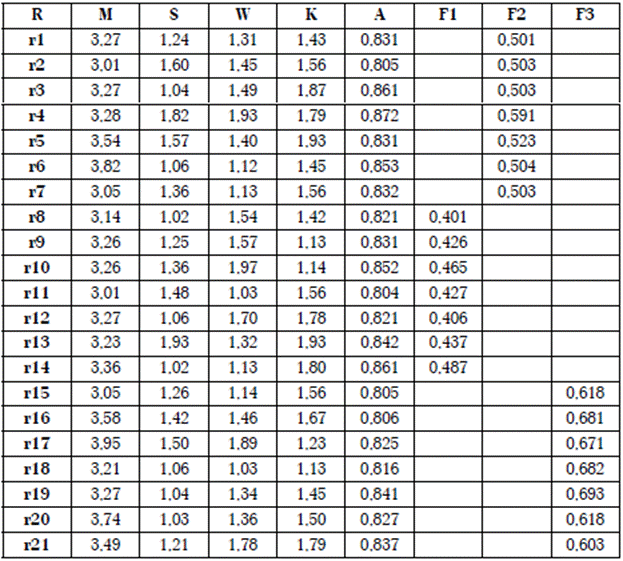
Source: Elaborated with the data of the study. R = Reactive, M = Mean, S = Standard Deviation, W = Sweddnes, K =Kurtosis, Crombach's alpha with values suppressing that of the item. Extraction method: main axes, rotation Promax. Adequacy and Sphericity [x2 = 324.25 (45gl) p = 0.000; KM O = 0.672] F1 = Expected Benefits of the Electoral Contest (25% of the total variance explained), F2 = Consensus Expectations (17% of the total variance explained). F3 = Intention to vote (28% of the total variance explained). Each item has response options such as: 0 = unlikely, 1 = very unlikely, 2 = unlikely, 3 = probable, 4 = very likely.
However, the low correlations between item arid factor expressed in factorial weights indicate a simple factorial structure of oblique type. The correlation between the factors or dimensions expected benefits and consensus expectations of the Consensus Expectations Scale, seems to indicate an association between the expected benefits of the electoral contests with respect to the consensus expectations (see Table 2). The relationship between the factors suggests a consistent governance in its contents, as well as in the reception of messages. Such a process suggests that the hearings process the information disseminated by the State. In that reception, the audiences link their adherence or militancy with their voting intentions. In the case of the surveyed sample, the students seem to show that they receive risk communication in a segmented way. University governance involves a balance of institutional, innovative, and interdependent factors, therefore, the relationships between the factors suggest that this balance is brewing between expectations and intentions. Spurious associations between the factors would imply an imbalance between the factors and the impossibility of governance. Even high correlations between the factors would show a collinearity that would be interpreted as a pragmatic institutionalism.
Table 2 Correlation and covariations

Source: Elaborated with data study. M = Mean, S = Standard Deviation, Fl = Expected Benefits of the Electoral Contest F2 = Consensus Expectations. F3 = Intention to vote: R = Reactive, e = Error
In this sense, electoral preferences would be the starting point to activate the voting intention process, since it is consensus expectations such as distrust, discontent, denunciation, responsibility, and social division that determine the intention to vote (see Figure 4). The structure of factors found suggests that the indicators or state messages are structured in three predominant dimensions, this means that a pandemic governance strategy, materialized in risk communication, consists of phases that the surveyed sample encapsulates in a process of negotiation, agreement, and intentions. The empirical test of the model through exploratory factor analysis of principal axes and Promax rotation demonstrates a transition towards governance. If the distribution of the responses to the items supposes a balance between institutionalism, agency, and solidarity, if the associations between the factors show an equilibrium in the making, the empirical test of the model suggests an incipient university governance, that is. the sample of respondents does not seem to be influenced by institutionalism. agency, or solidarity. University governance for respondents is an unverifiable or comparable abstraction.
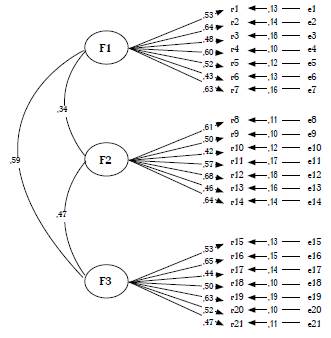
Source: Elaborated with data study. Fl = Expected Benefits of the Electoral Contest, F2 = Consensus Expectations. F3 = Intention to vote: R = Reactive, e = Error
Figure 4 Structural Equation Modelling
Finally, the adjustment and residual indicators \\2 = 214.3o (4/gl) p = 0.007: GFI = 0.990: GFI = 0.997: RMSSEA = 0.001] suggest the acceptance of the null hypothesis regarding the co-correspondence between the theoretical relations of the variables with respect to the findings.
Discussion
The contribution of the present work was to contrast a model of strategic governance, establishing three phases related to the negotiating provisions, the expected benefits, and the voting intentions. It is a phenomenon in which the parties involved establish negotiation features, benefits and intentions based on the surrounding information in the media, disguised as state propaganda (Sánchez et al. 2017). In the case of governance benefits, immunization from the pandemic is an expectation derived from state communication. In this sense, the return to class strategy is legitimized as an expectation of consensus in the surveyed sample.
The established governance model included three factors that explained 70% of the variance, suggesting that the instrument can be extended to a fourth dimension that the literature identifies as risk perception. It is a factor that explains and anticipates contingent events such as the pandemic and its effects on the relationship between the rulers and the ruled. Through the establishment of a public health agenda, the State's governance strategy legitimizes its management in the face of the pandemic avoiding social, political, and citizen participation (Bustos et al. 2020). this is so. because the public security is assumed as a state guide that prevents risks but is not responsible for public health in the face of Co\id-19. delegating that co-responsibility to the citizenry, in other words, the individualization of contagion, disease, and death by Covid-19 is a strategy of the regime to spread exposure to risks as inevitable in the return to classes.
In relation to the theories that explain governance, this study warns that respondents consider anti-Covid-19 policy and their participation abstract. The respondents reflect a management, production and transfer of knowledge limited by distancing from institutional norms, innovations from their peers, and emotional solidarity in the face of the health crisis (Garcia et al. 2016). Return to classrooms is uncertain because respondents are not influenced by the epidemiological traffic light. Study lines related to the incidence of innovative proposals in the respondents will allow observing the agency. Future research concerning emotions as determinants of decisions and actions will reveal how involved the actors are. University governance is inexorable to knowledge generating HEIs but abstract for those surveyed.
Regarding the studies of university governance where work, innovative, and supportive climates converge, the present work warns of an incipient convergence of factors. The transition to governance indicates a conflict between the actors, but the present research shows that a reordering of factors prevails. The pandemic created a climate of uncertainty in the surveyed sample. Studies on the climate of tasks, innovation, and supports report robust associations, although in the present work barely significant relationships were observed between the factors. The measurement of other factors such as risk behaviours will make it possible to define the influence of the task evironment. innovations, and supports (Garcia et al. 2012). University governance can be examined from the results of expectations, norms, and values. The pandemic would be anticipated as a phenomenon of discussion, consensus, and shared responsibility.
Regarding the modelling of university governance, this study suggests extensive measurement of normative and evaluative variables. The prediction of a behaviour derived from university governance would indicate the level of institutionalization, innovation, and solidarity among the respondents. The instruments to measure the incidence of norms and values will allow progress towards the prediction of governance in exceptional situations (Martinez et al. 2019). The pandemic can be abated if the actors deliberate, plan, and systematize their discussions, agreements, and co-responsibilities. Universities with governance would be distinguished by their degree of participation oriented towards balancing demands and resources.
Conclusion
The contribution of the present work to the state of the question lies in the contrast of a model. It is a structure of relationships between factors and indicators: such dimensions suggest a sequence of expectations in the surveyed sample regarding the return to classes interrupted by the pandemic. In relation to containment and mitigation policies, promoted as strategies, the inclusion of citizens' expectations as audiences exposed to the State's messages is suggested. In the virtual classroom, the exposed findings can contribute to the dissemination of the governance strategy, this is possible if it is considered that the differences between the parties can be overcome by their coincidences.














